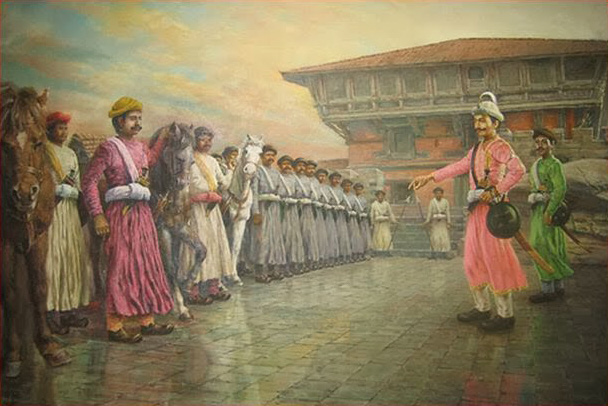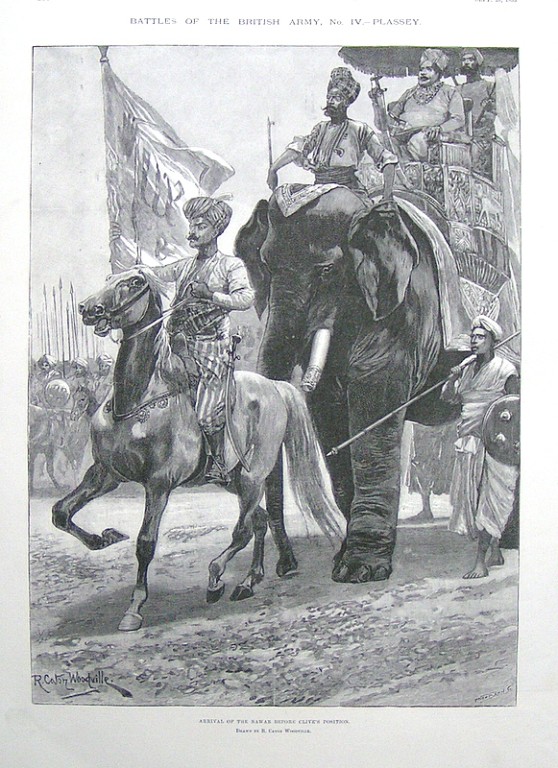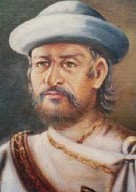|
Naahar Singh Basnyat
Naahar Singh Basnyat was a soldier who fought against the forces of Mir Qasim Mir Qasim ( bn, মীর কাশিম; died 8 May 1777) was the Nawab of Bengal from 1760 to 1763. He was installed as Nawab with the support of the British East India Company, replacing Mir Jafar, his father-in-law, who had himself been su .... He was eldest son of Shivaram Singh Basnyat. He fought against Kings of Kathmandu valley. He fought against Tibet in 1845 B.S. References Year of birth missing Year of death missing Nepalese military personnel Basnyat family 18th-century Nepalese nobility People of the Nepalese unification {{Nepal-bio-stub ... [...More Info...] [...Related Items...] OR: [Wikipedia] [Google] [Baidu] |
Unification Of Nepal
The Unification of Nepal, also known as Expansion of Gorkha Kingdom, officially began in 1743 AD (1799 BS) after King Prithvi Narayan Shah of Gorkha launched an aggressive annexation campaign seeking to broaden his own kingdom's border. After conquering the Nepal Mandala, which consisted of the different city-states of the Kathmandu, Lalitpur, Kirtipur and Bhaktapur, Shah moved his hilly capital in Gorkha to the fertile and wealthy city of Kathmandu and adopted the name Nepal for the entire Gorkha Empire. The Shah dynasty would go on to expand the various warring kingdoms that once occupied parts of present-day Nepal into a nation-state that stretched up to the Sutlej River in the west and Sikkim-Jalpaiguri in the east. Before usage by the Gorkha Empire, the Kathmandu Valley was known as Nepal after the Nepal Mandala, the region's Nepal Bhasa name. Invasion of Nuwakot Prithvi Narayan Shah's annexation campaign began with the nearby kingdom of Nuwakot. Nuwakot marked the ... [...More Info...] [...Related Items...] OR: [Wikipedia] [Google] [Baidu] |
Shivaram Singh Basnyat
Shivaram Singh Basnyat ( ne, शिवराम सिंह बस्न्यात) was the military commander of Gorkha. After the conquest of Naldum area by the Gorkhalis, he along with Commander Bir Bhadra Thapa conquered Sanga, Panauti, Sankhu and adjacent areas. They received fierce resistance from the Kantipur Kingdom at Sangachok. He died in the defensive battle of Sanga Chowk during Unification of Nepal on 1803 B.S. Personal life He was born to Jayaram Singh Basnyat in the clan of Shreepali among Basnyats. He had four sons - Naahar Singh Basnyat, Kehar Singh Basnyat Kehar Singh Basnyat ( ne, केहरसिंह बस्न्यात) or Kehar Singh Basnet was a Nepalese military commander and warhero who led down his life in the Unification battles of Nepal. He was born in the illustrious clan of Shr ..., Abhiman Singh Basnet and Dhokal Singh Basnyat. His third son went on to become Supreme Commander of the Nepalese Army and Chief Minister ( Mulkazi) in ... [...More Info...] [...Related Items...] OR: [Wikipedia] [Google] [Baidu] |
Kaji (Nepal)
''Kaji'' ( ne, काजी) was a title and position used by nobility of Gorkha Kingdom (1559–1768) and Kingdom of Nepal between 1768 and 1846. Many other contemporary kingdoms used the same title for their ministers. Etymology Historian Mahesh Chandra Regmi suggests that ''Kaji'' is derived from Sanskrit word ''Karyi'' which meant functionary. History Ganesh Pande was the first Kaji under King Dravya Shah of Gorkha Kingdom. He helped Dravya Shah to become King of Gorkha and was later appointed Kaji of Gorkha in 1559 A.D. Another significant Kaji of Gorkha was Kalu Pande born in the family of Ganesh Pande. He was son of Bhimraj Pande who was also a Kaji during the reign of King Nara Bhupal Shah. Kalu Pande led Gorkhalis in the Battle of Kirtipur. He had set up a base on Naikap, a hill on the valley's western rim, from where they were to mount their assaults on Kirtipur. He was killed in the battle after being surrounded by enemy forces. The ministers and officials of Kantipu ... [...More Info...] [...Related Items...] OR: [Wikipedia] [Google] [Baidu] |
Mir Qasim
Mir Qasim ( bn, মীর কাশিম; died 8 May 1777) was the Nawab of Bengal from 1760 to 1763. He was installed as Nawab with the support of the British East India Company, replacing Mir Jafar, his father-in-law, who had himself been supported earlier by the East India Company after his role in winning the Battle of Plassey for the British. However, Mir Jafar eventually ran into disputes with the East India Company and attempted to form an alliance with the Dutch East India Company instead. The British eventually defeated the Dutch at Chinsura and overthrew Mir Jafar, replacing him with Mir Qasim. Qasim later fell out with the British and fought against them at Buxar. His defeat has been suggested as a key reason in the British becoming the dominant power in large parts of North and East India. Early life and family Sayyid Mir Qasim was the son of Mir Muhammad Razi Khan, and claimed descent from Ali al-Ridha. His paternal grandfather, Sayyid Husayn Ridhwi, entered the ... [...More Info...] [...Related Items...] OR: [Wikipedia] [Google] [Baidu] |
Year Of Birth Missing
A year or annus is the orbital period of a planetary body, for example, the Earth, moving in its orbit around the Sun. Due to the Earth's axial tilt, the course of a year sees the passing of the seasons, marked by change in weather, the hours of daylight, and, consequently, vegetation and soil fertility. In temperate and subpolar regions around the planet, four seasons are generally recognized: spring, summer, autumn and winter. In tropical and subtropical regions, several geographical sectors do not present defined seasons; but in the seasonal tropics, the annual wet and dry seasons are recognized and tracked. A calendar year is an approximation of the number of days of the Earth's orbital period, as counted in a given calendar. The Gregorian calendar, or modern calendar, presents its calendar year to be either a common year of 365 days or a leap year of 366 days, as do the Julian calendars. For the Gregorian calendar, the average length of the calendar ... [...More Info...] [...Related Items...] OR: [Wikipedia] [Google] [Baidu] |
Year Of Death Missing
A year or annus is the orbital period of a planetary body, for example, the Earth, moving in its orbit around the Sun. Due to the Earth's axial tilt, the course of a year sees the passing of the seasons, marked by change in weather, the hours of daylight, and, consequently, vegetation and soil fertility. In temperate and subpolar regions around the planet, four seasons are generally recognized: spring, summer, autumn and winter. In tropical and subtropical regions, several geographical sectors do not present defined seasons; but in the seasonal tropics, the annual wet and dry seasons are recognized and tracked. A calendar year is an approximation of the number of days of the Earth's orbital period, as counted in a given calendar. The Gregorian calendar, or modern calendar, presents its calendar year to be either a common year of 365 days or a leap year of 366 days, as do the Julian calendars. For the Gregorian calendar, the average length of the calendar year (t ... [...More Info...] [...Related Items...] OR: [Wikipedia] [Google] [Baidu] |
Nepalese Military Personnel
Nepali or Nepalese may refer to : Concerning Nepal * Anything of, from, or related to Nepal * Nepali people, citizens of Nepal * Nepali language, an Indo-Aryan language found in Nepal, the current official national language and a language spoken in India * Nepal Bhasa, a Sino-Tibetan language found in Nepal, formerly the official national language * Nepalese literature * Nepalese cuisine * Nepalese culture * Nepali cinema * Nepali music Other uses * ''Nepali'' (film), a 2008 Indian Tamil-language film See also * Nepal (other) * * * Languages of Nepal * Nepal Nepal (; ne, नेपाल ), formerly the Federal Democratic Republic of Nepal ( ne, सङ्घीय लोकतान्त्रिक गणतन्त्र नेपाल ), is a landlocked country in South Asia. It is ma ... is a south Asian country with a population of nearly 30 million. {{disambiguation Language and nationality disambiguation pages ... [...More Info...] [...Related Items...] OR: [Wikipedia] [Google] [Baidu] |
Basnyat Family
Basnyat/Basnet family or Basnyat/Basnet dynasty ( ne, बस्न्यात वंश/बस्न्यात काजी खलक) was a Khas-Chhetri and a warlord clan family involved in the politics and administration of the Gorkha Kingdom and Kingdom of Nepal. This family got entry into Thar Ghar aristocracy group of Gorkha at the time of King Prithvi Narayan Shah. It was one of the four noble families to be involved in active politics of Nepal together with Shah dynasty, Pande family and Thapa dynasty before the rise of Rana dynasty. This family is descended from Shivaram Singh Basnyat, the commander of Gorkhali forces and a member of Shreepali Basnyat clan of Gorkha. This family was maritally linked to ''Kala'' (Black) Pande section of Pande dynasty through Chitravati Pande who married Kaji Kehar Singh Basnyat. This family was the last Kshatriya (Chhetri) political family to be wiped out from the central power by Jung Bahadur Rana of Kunwar family during the Bhandar ... [...More Info...] [...Related Items...] OR: [Wikipedia] [Google] [Baidu] |
18th-century Nepalese Nobility
The 18th century lasted from January 1, 1701 ( MDCCI) to December 31, 1800 ( MDCCC). During the 18th century, elements of Enlightenment thinking culminated in the American, French, and Haitian Revolutions. During the century, slave trading and human trafficking expanded across the shores of the Atlantic, while declining in Russia, China, and Korea. Revolutions began to challenge the legitimacy of monarchical and aristocratic power structures, including the structures and beliefs that supported slavery. The Industrial Revolution began during mid-century, leading to radical changes in human society and the environment. Western historians have occasionally defined the 18th century otherwise for the purposes of their work. For example, the "short" 18th century may be defined as 1715–1789, denoting the period of time between the death of Louis XIV of France and the start of the French Revolution, with an emphasis on directly interconnected events. To historians who expand the ... [...More Info...] [...Related Items...] OR: [Wikipedia] [Google] [Baidu] |




